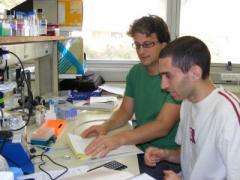Scientists find clue to mystery of biological clock

How does our biological system know that it is supposed to operate on a 24-hour cycle? Scientists at the Hebrew University of Jerusalem have discovered that a tiny molecule holds the clue to the mystery.
Human as well as most living organisms on earth possess circadian a (24-hour) life rhythm. This rhythm is generated from an internal clock that is located in the brain and regulates many bodily functions, including the sleep-wake cycle and eating.
Although the evidence for their existence is obvious and they have been studied for more than 150 years, only recently the mechanisms that generate these rhythms have begun to be unraveled.
A researcher of the Alexander Silberman Institute of Life Sciences at the Hebrew University, Dr. Sebastian Kadener, and one of his students, Uri Weissbein, are among a collaborative group of researchers that have now found that tiny molecules known as miRNAs are central constituents of the circadian clock. Their discovery holds wide-ranging implications for future therapeutic treatment to deal with sleep deprivation and other common disorders connected with the daily life cycle.
The sleep-wake cycle, the most characterized manifestation of the circadian clock, is generated thanks to specialized neurons found both in humans and fruitflies. (The mechanism governing the circadian clock in fruitflies is almost identical to the one mammals -- and humans -- have.)
These neurons have the striking capability of counting time very accurately via a complex process of gene activation and repression that result in a tightly controlled process that takes exactly 24 hours.
The new research by Dr. Kadener and his colleagues, published in an article in the journal Genes and Development (and that was highlighted in Nature Review Neuroscience), has shown that a new mode of regulation has a pivotal importance for the ability of our internal clock to accurately count those 24 hours each day. Specifically, they have shown that the very tiny miRNA molecules are necessary for the circadian rhythms to function.
MiRNAs have recently been discovered and have been shown to be involved in different processes in animals. By the use of new state-of-the-art techniques (most of them developed in the present study) the authors demonstrate that one specific miRNA (called bantam) recognizes and regulates the translation of the gene clock.
This constitutes the first example of a defined miRNA-gene regulation in the central clock. Perhaps even more importantly, the researchers were among the first to prove that there is a clear role of miRNA regulation in the brain in general and behavior in particular.
Source: Hebrew University of Jerusalem















